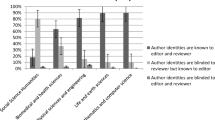Abstract
Peer review is a classic method in the field of quality analysis, but the effectiveness of peer reviewing has never been researched using quantity analysis indicators. A new indicator for academic journals, Effectiveness of Peer Review (EPR), is defined for evaluating the effectiveness of peer reviewing. If the assumption is valid, EPR could be a simple indicator of such effectiveness. In a sample experiment, 28 academic journals were tested, and the EPR indicator was able to reflect accurately the academic impact of those journals.


Similar content being viewed by others
References
Aarssen, L. W. (2008). Bang for your buck: Rejection rates and impact factors in ecological journals. The Open Ecology Journal, 1, 14–19.
American Psychological Association. (2009). Summary report of journal operations, 2008. American Psychologist, 64(5), 504–505.
American Psychological Association. (2010). Summary report of journal operations, 2009. American Psychologist, 65(5), 524–525.
American Psychological Association. (2011). Summary report of journal operations, 2010. American Psychologist, 66(5), 405–406.
Berk, R. N., et al. (1995). New category of peer review decision: Rejection with opportunity to revise and resubmit. American Journal of Roentgenology, 164, 235.
Carrió, I. (2006). On cloning research, peer review and the possibility of fraud. European Journal of Nuclear Medicine and Molecular Imaging, 33, 235–236.
Cicchetti, D. V. (1997). Referees, editors, and publication practices: Improving the reliability and usefulness of the peer review system. Science and Engineering Ethics, 3, 51–62.
Eisenhart, M. (2002). The paradox of peer review: Admitting too much or allowing too little. Research in Science Education, 32(2), 241–255.
Elsevier (2008). Elsevier editorial system (EES) and peer review. A guide to publishing in scholar journals.
Fletcher, R. H. (1997). Evidence for the effectiveness of peer review. Science and Engineering Ethics, 3, 35–50.
Glänzel, W., et al. (2003). Better late than never? On the chance to become highly cited only beyond the standard bibliometric time horizon. Scientometrics, 58(3), 571–586.
Godlee, F., et al. (1998). Effect on the quality of peer review of blinding reviewers and asking them to sign their reports: A randomized controlled trial. Journal of American Medical Association, 280, 237–240.
Guo, Yu., et al. (2007). Biblio-metrilogical analysis on development trend of computer science in China. Application Research of Computer, 24(12), 28–31.
Hojat, M., et al. (2003). Impartial judgment by the “gatekeepers” of Science: Fallibility and accountability in the peer review process. Advances in Health Sciences Education, 8, 75–96.
Jefferson, T., et al. (2007). Editorial peer review for improving the quality of reports of biomedical studies. Cochrane Database System Review, 18(2), MR000016.
Jefferson, T., et al. (2002a). Effects of editorial peer review. JAMA, 287(21), 2784–2786.
Jefferson, T., et al. (2002b). Measuring quality of editorial peer review. JAMA, 287(21), 2786–2790.
Južnic, P., et al. (2010). Scientometric indicators: Peer-review, bibliometric methods and conflict of interests. Scientometrics, 85, 429–441.
Kundzewicz, Z. W., et al. (2005). Editorial—the peer-review system: Prospects and challenges. Hydrological Sciences–Journal–des Sciences Hydrologiques, 50(4), 577–590.
Larivière, V., et al. (2009). The decline in the concentration of citations, 1900–2007. Journal of the American Society for Information Science and Technology, 60, 858–862.
Li, X., (2008). On the peer review in international journals. http://www.sciencenet.cn/m/user_content.aspx?id=31867. Accessed on 2008-7-11.
Liang, L., et al. (2009). Delayed recognition: Sleeping beauties in science. Journal of Dialectics of Nature, 31(1), 39–45.
Lock, S. (1994). Does editorial peer review work? Annuals of Internal Medicine, 212(1), 59–61.
Ma, Z., et al. (2012). Effectiveness of peer review (EPR): A new indicator of academic journal. Journal of the China Society for Scientific and Technical Information, 30(3), 303–308.
Ren, S. (2004). Academic paper’s peer review. The Chinese Journal of Nonferrous Metals, 14(11), F002–F003.
Ren, S. (2009). Defects of peer review. Scientific News, 23, 59.
Rennie, D. (2003). Editorial peer review: Its development and rationale. In F. Godlee, T. Jefferson (Eds.), Peer Review in Health Sciences (pp. 1–13). London: BMJ Publishing Group.
Rotton, J., et al. (1993). Citation impact, rejection rates, and journal value. American Psychologist, 48(8), 911-912
Schroeder, W. H. (1988). Peer Review: A foundation of science. Environmental Science and Technology, 22(3), 235.
Schultz, D. M. (2010). Rejection rates for journal publishing in the atmospheric science. Bulletin of American Meteorological Society, 91, 231–243.
Stefanou, S. E. (2008). Applied production analysis unveiled in open peer review: Introductory remarks. Journal of Productivity Analysis, 20, 1–6.
Thatje, S. (2010). The multiple faces of journal peer review. Naturwissenschaften, 97, 237–239.
Tobin, M. J. (2002). Rigor of peer review and the standing of a journal. American Journal of Respiratory and Critical Care Medicine, 166, 1013–1018.
Van Raan, A. F. J. (2004). Sleeping beauties in science. Scientometrics, 59(3), 467–472.
Veitch, E. (2001). Reviewing peer review: The fourth international congress on peer review in biomedical publication. BMC News and Views, 2, 7–8.
Warner, J. O. (2007). Increasing rejection rates for a successful journal. Pediatric Allergy Immunology, 18, 179.
Yoshida, Y. (2006). Peer review system: Any other choice? International Journal of Hematology, 83, 191–192.
Acknowledgments
This research was supported by the National Natural Science Foundation of China (No. 70973118).
Author information
Authors and Affiliations
Corresponding author
Rights and permissions
About this article
Cite this article
Ma, Z., Pan, Y., Yu, Z. et al. A quantitative study on the effectiveness of peer review for academic journals. Scientometrics 95, 1–13 (2013). https://doi.org/10.1007/s11192-012-0879-2
Received:
Published:
Issue Date:
DOI: https://doi.org/10.1007/s11192-012-0879-2




